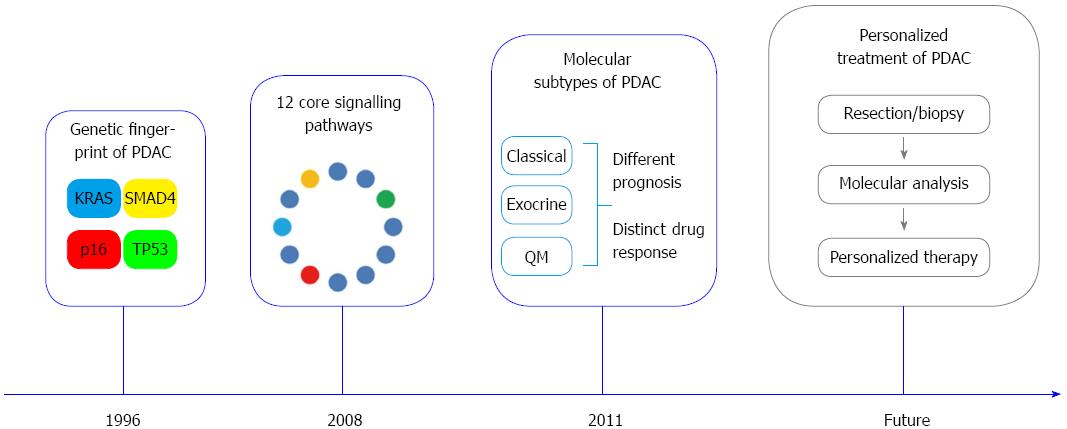Copyright
©2014 Baishideng Publishing Group Inc.
World J Gastroenterol. Oct 14, 2014; 20(38): 13833-13841
Published online Oct 14, 2014. doi: 10.3748/wjg.v20.i38.13833
Published online Oct 14, 2014. doi: 10.3748/wjg.v20.i38.13833
Figure 1 Precursor lesions of pancreatic ductal adenocarcinoma in familial pancreatic cancer-patients.
A: Low-grade pancreatic intraepithelial neoplasia; B: Gastric-type intraductal papillary mucinous neoplasm showing a ductal phenotype; C: Acinar-ductal metaplasia in areas of lobulocentric atrophy. Arrows indicate an atypical flat lesion; D: Atypical flat lesion with cellular atypia and typical stromal reaction.
Figure 2 Dual model of pancreatic carcinogenesis.
The well-known precursor lesions (PanIN, IPMN and MCN) show a ductal phenotype. However, it seems now plausible that pancreatic ductal adenocarcinoma can directly originate from the centroacinar-acinar compartment through atypical flat lesions without the intermediate step of pancreatic intraepithelial neoplasia (PanIN) (acinar-ductal carcinogenesis). MCN: Mucinous cystic neoplasm; IPMN: Intraductal papillary mucinous neoplasm; ADM: Acinar ductal metaplasia; TC: Tubular complexes; MTC: Mucinous tubular complexes; AFL: Atypical flat lesion.
Figure 3 Dispersed growth of pancreatic ductal adenocarcinoma.
Tumor deposits (star) of pancreatic ductal adenocarcinoma are found many mm away from the main tumor bulk. The curved line highlights the tumor front.
Figure 4 Milestones in pancreatic cancer biology.
Mutations of KRAS, CDKN2A/p16, SMAD4 and TP53 represent the molecular fingerprint of pancreatic ductal adenocarcinoma (PDAC)[53]. Global genomic analysis of PDAC defined a set of 12 core signalling pathways commonly altered in the great majority of investigated tumors[17]. Three distinct molecular PDAC subtypes [“classical”, “quasi-mesenchymal” (QM) and “exocrine-like”] with prognostic relevance and distinct drug response were defined based on combined analysis of transcriptional profiles of primary tumor samples and human and mouse PDAC cell lines[54].
- Citation: Esposito I, Konukiewitz B, Schlitter AM, Klöppel G. Pathology of pancreatic ductal adenocarcinoma: Facts, challenges and future developments. World J Gastroenterol 2014; 20(38): 13833-13841
- URL: https://www.wjgnet.com/1007-9327/full/v20/i38/13833.htm
- DOI: https://dx.doi.org/10.3748/wjg.v20.i38.13833












